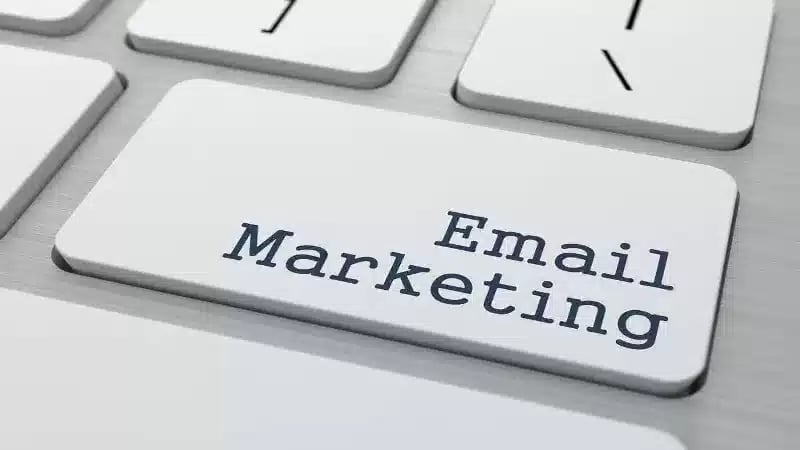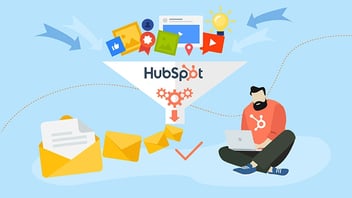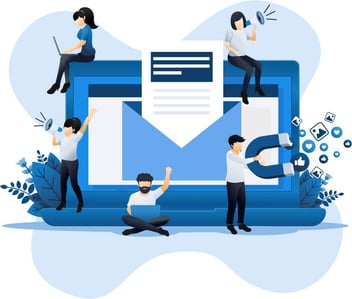Top 15 Benefits of Email Marketing for Small Business
Just about everyone uses email daily: individuals, small businesses, and large corporations. We check our inboxes before breakfast, send an email during the commute, and on coffee breaks. Email is an efficient and cost-effective way to establish communication between your brand, prospects, and customers.
Let's explore some of the top benefits of email marketing and why it should be an essential part of your digital marketing strategy.
Why Does Email Marketing Matter?
-
McKinsey estimates that Emailing regularly is about 40 times more effective, with a better return on investment, than Facebook and Twitter in helping your business acquire new customers.
-
Email marketing has an average ROI of 4200%, meaning that for every $1 spent on email marketing, the average return is $42 [Mailchimp].
-
Personalized emails have an average open rate of 29% and a click-through rate of 5%, compared to non-personalized emails with an average open rate of 15% and a click-through rate of 1% [HubSpot].
-
Marketing Emails with your recipient's first name in the email subject line have a 26% higher open rate than those without personalization [AWeber].
-
Segmented email campaigns have a 14.31% higher open rate than non-segmented campaigns and a 100.95% higher click-through rate [Constant Contact].
-
80% of business professionals believe email marketing increases customer retention [Mailchimp].
-
Email marketing has an average conversion rate of 66% for online retailers, compared to 2% for social media platforms [HubSpot].
-
Automated welcome emails have an average open rate of 82%, compared to 25% for promotional emails [AWeber].
-
Email marketing is 40 times more effective at acquiring new customers than Facebook or Twitter [Constant Contact].
-
Email marketing has an average click-through rate of 7%, compared to 0.5% for Facebook and 0.2% for Twitter [Mailchimp].
-
72% of people prefer receiving promotional content through email, compared to 17% who prefer social media [HubSpot].
The following lists key email marketing benefits for businesses:
1. Increase Brand Awareness
By using email marketing, you can enhance your brand recognition with both new and potential clients. As your messages are forwarded or shared, your organic reach is extended. Consistent updates to your existing and potential customers allow you to showcase your brand's unique personality, style, and image.
Once you've created a brand style guide complete with your company's branding guidelines, follow it in every email. It's an opportunity to connect with your subscribers and further cement your brand identity.
Customers are exposed to your business and brand with every email. You build value with strategic planning, clever design, and targeted content. Consistent and helpful emails keep you top-of-mind for existing customers and inspire leads to convert.
Your brand style guide is the key to success in every email. It's an opportunity to connect with your subscribers and reinforce your brand identity. Every email in your customer's inbox is a chance to build value with strategic planning, innovative design, and targeted content. Consistent and helpful emails keep you top-of-mind for existing customers and inspire leads to convert. So, follow your brand style guide and make every email count!
Tip: Use a consistent brand style guide in your emails.
Example: Your brand style guide would likely feature your logo, color scheme, font choices, and tone of voice. Consistency is key when incorporating these elements into your email marketing strategy, allowing customers to recognize your brand and develop a strong brand association easily.
Here are some specific things you can do to use a consistent brand style guide in your emails:
-
-
Use your company's logo in the header of every email.
-
Use your company's colors throughout the email.
-
Use your company's fonts for the body text and headings
-
Write in your company's tone of voice.
-
Following these tips, you can use email marketing to increase brand awareness and build a strong relationship with your customers.
2. Reach Targeted Audiences
Tailoring your types of emails to your audience's interests and needs is crucial for delivering relevant content that drives engagement and boosts conversion rates. This involves segmenting your email list, crafting attention-grabbing subject lines, utilizing impactful imagery, and providing valuable content that resonates with each targeted segment of your audience.
Tip: Segment your email list and send targeted emails.
Example: By dividing your subscribers based on gender, age, and location, you can tailor your content to their specific interests. For instance, you could send a sales email to women in the United States, launch a new product for men in Europe, and share fashion trends with people of all ages living in Asia. This approach ensures that your subscribers receive relevant content, increasing engagement and boosting conversion rates.
By segmenting your email list, you can ensure your subscribers receive the most relevant content. This will help you to increase engagement and boost conversion rates. Here are some specific things you can do to segment your email list:
-
-
Ask your subscribers to provide demographic information when they sign up for your list.
-
Use tools like HubSpot, Mailchimp, or Constant Contact to segment your list based on subscriber data.
-
Send different types of emails to different segments of your list.
-
With this, you can segment your email list and send targeted emails that resonate with your audience.
3. Build Authority and Credibility
Utilize email marketing to showcase your expertise in your niche by delivering curated content that keeps your customers informed about your business. Consistent communication allows you to build credibility and trust with your audience, making them more likely to turn to you for their needs. As you share your knowledge and expertise, your customers will continue to see you as a thought leader in your industry.
Creating relevant and timely content for your intended audience establishes a continued rapport and trust with your current customers, increasing your exposure and credibility. Encourage your subscribers to share your content to expand your reach further. It's essential to ensure your sending credentials are good to avoid spam filters and provide an easy opt-out option for customers who may no longer be interested in receiving your emails.
Tip: Share valuable content that showcases your expertise.
Example: Let's say you're a company that sells shoes. You could share blog posts about the latest fashion trends, tips on caring for your shoes, or interviews with experts in the shoe industry. You could also share infographics, videos, or case studies demonstrating your expertise.
By sharing valuable content, you can position yourself as an expert. This will help you to build trust and credibility with your audience, making them more likely to do business with you. Here are some specific things you can do to share valuable content:
-
-
Write blog posts about industry trends and topics.
-
Create infographics and videos that explain your products or services.
-
Share case studies that demonstrate your expertise.
-
Interview experts in your field.
-
Promote content from other thought leaders in your industry.
-
This lets you share valuable content that will help you to build authority and credibility with your audience.
4. Create Excitement
Each customer is unique, and providing them with the same incentives won't cut it. Instead, align incentives based on their interests and characteristics. Customers will appreciate rewards like an exclusive sale invite, a limited discount, or behind-the-scenes access. This thoughtful gesture makes them feel valued and creates a sense of excitement and exclusivity that can boost your business.
Tip: Offer exclusive incentives.
Example: Let's say you sell shoes. You could offer your subscribers an exclusive discount code for a new line of shoes that you're launching. You could also offer them early access to new products or services.
By offering exclusive incentives, you can create a sense of excitement and urgency among your subscribers. This will make them more likely to open and read your emails and make them more likely to take action, such as making a purchase. Here are some specific things you can do to offer exclusive incentives:
-
-
Offer discounts or coupons.
-
Offer early access to new products or services.
-
Offer free shipping or other perks.
-
Offer exclusive content, such as blog posts, infographics, or videos.
-
By following these tips, you can offer exclusive incentives that will help you to create excitement and boost your email marketing campaigns.
5. Increase Product and Service Visibility
There's always a good chance customers don't know about all the different products and services you offer. Taking a proactive approach means enhancing the exposure of all your products and services, and email marketing are an effective means to build the visibility you need.
Tip: Promote your products and services in your emails.
Example: In retail, you could promote your products in your emails by sending out product catalogs, highlighting new arrivals, or offering discounts on specific products.
By promoting your products and services in your emails, you can increase their visibility to your subscribers. This will make them more likely to purchase your products or services. Here are some specific things you can do to promote your products and services in your emails:
- Send out product catalogs.
- Highlight new arrivals.
- Offer discounts on specific products.
- Create email campaigns that are specifically designed to promote your products and services.
By following these tips, you can promote your products and services in your emails and increase their visibility to your subscribers.
6. Foster Strong Customer Relationships
Email marketing lets you maintain a strong presence in your customers' minds and keep them engaged with your brand. By providing the latest updates and information about your business, you show them that you value their interest and care about their needs. With consistent communication, you can build a loyal customer base that trusts your expertise and relies on your business for its needs.
Regular newsletters are a great way to keep your customers up-to-date with the latest developments in your business, including new products, exciting events, and relevant news. If your customers have opted-in to receive emails, don't hesitate to share timely announcements, exclusive offers, and other product developments to keep them engaged and interested. By consistently providing valuable content, you can build a loyal customer base that trusts your expertise and relies on your business for its needs.
Automated email campaigns can be a game-changer in building a solid customer relationship. By providing consistent value and helpful information over some time, you can keep your brand at the forefront of your customer's minds. These campaigns offer helpful tips, products, and information catering to your customers' needs and interests.
Tip: Send regular emails relevant to your subscribers' interests.
Example: As a shoe retailer, you can keep your subscribers engaged with your brand by sending them a weekly email newsletter featuring the latest company news, new arrivals, and exclusive offers. Additionally, you can offer monthly emails with expert tips on how to care for and style their shoes for different occasions.
By sending regular emails relevant to your subscribers' interests, you can keep them engaged and build a strong relationship with your brand. Here are some specific things you can do to send regular emails that are relevant to your subscribers' interests:
-
-
Ask your subscribers what they're interested in. You can do this through surveys, polls, or simply by asking them when they sign up for your email list.
-
Segment your email list. This will allow you to send different emails to different segments of your list based on their interests and needs.
-
Personalize your emails. Address your subscribers by name and use relevant content.
-
Use visuals. Images and videos can help to capture attention and make your emails more visually appealing.
-
Use a strong call to action. Tell your subscribers what you want them to do, such as visit your website, sign up for a newsletter, or make a purchase.
-
By following these tips, you can send regular emails relevant to your subscribers' interests and build a strong relationship with them.
7. Gain Insight with Measurable Data
Email marketing software provides precise and valuable data and metrics beyond numbers and percentages.
Insights into customer behaviors and interests allow you to measure the success of your marketing campaign and make data-driven decisions.
Use this information to tailor your strategy towards the most effective campaigns and topics of interest, ensuring your content resonates with your audience and drives engagement.
Monitoring your open and click-through rates can provide valuable insights into your customers' interest in your brand and content. However, the ultimate goal of email marketing is to convert these interested readers into loyal customers. By analyzing your conversion rates, you can determine the effectiveness of your call-to-action and make necessary adjustments to improve future campaigns.
Tip: Use email marketing software to track your results.
Example: Let's say you use an email provider like HubSpot, Mailchimp, or Constant Contact to send out your email marketing campaigns. All three will provide you with various data and metrics, including open rates, click-through rates, and conversion rates.
You can see what's working and what's not by tracking your results. You can then use this information to improve your future email marketing campaigns. Here are some specific things you can do to use email marketing software to track your results:
-
-
Track your email open rates. This will tell you how many people are opening your emails.
-
Track your click-through rates. This will tell you how many people click on your emails' links.
-
Track your conversion rates. This will tell you how many people are taking the desired action, such as making a purchase or signing up for a newsletter.
-
You can see what's working and what's not by tracking your results. You can then use this information to improve your future email marketing campaigns.
8. Increase Sales and Web Traffic
Email marketing can be a powerful tool for encouraging impulse buying. By showcasing items frequently purchased together, offering a list of similar products, or providing special discounts for future purchases, you can entice your readers to take action and make a purchase. This can help increase sales and drive revenue for your business.
Drive traffic to your website by strategically placing relevant links within your email content. Additionally, provide your audience with engaging information about other pieces of content available on your website. Don't forget to include social sharing buttons to encourage the promotion of your content across your customers' social channels, giving your brand that extra organic reach.
9. Conversation starter
Email marketing allows you to start a two-way conversation that benefits you and your readers. Don't just push your message out; encourage them to share feedback and ideas. Share useful advice, news, and educational content and encourage feedback to continue building your reputation and strengthening customer relationships.
Ask what they thought of the advice, news, and educational data you've included in your email. Ask what other questions they have or what they'd like to see addressed in future emails.
10. Cost-effective
Email marketing is a budget-friendly way to reach a wider audience than other marketing channels like direct mail or paid advertising. It's an alluring option for businesses of all sizes, allowing them to communicate with their subscribers without hurting their bottom line.
Scalability and automation are core advantages of email marketing, making it a cost-effective option for businesses looking to reach a large and growing audience. As your business expands, you can effortlessly add more subscribers to your email list and send more emails without causing significant additional costs. What's more, email marketing platforms with pay-as-you-go pricing offer businesses the flexibility to pay only for the emails they send, which helps control marketing costs and maintain their budget.
11. Personalization
Personalization is a key advantage of email and content marketing, enabling businesses to tailor their messages to their audience's interests and needs, delivering a personalized experience that resonates with customers. This approach increases email relevance and effectiveness by encouraging customers to engage with messages that are meaningful to them, driving higher engagement and action rates.
Think back to when you've received emails that felt robotic, impersonal, or boring. Nobody wants to read an email that sounds like that! Instead, explore ways to craft emails that engage, inform, and resonate with your audience.
Personalizing your emails is essential to building stronger relationships with your audience. Techniques such as using the recipient's name in the subject line and body of the email, segmenting your email list based on interests or behaviors, and using dynamic content to display different content to different users can make your emails feel more like a one-on-one conversation. This personalized approach can increase engagement and make your audience feel valued.
12. Mobile-friendly
In today's digital age, where mobile devices have become an indispensable part of our lives, ensuring that your email marketing strategy is mobile-friendly is crucial. Optimizing your emails for mobile devices allows you to reach your audience wherever they are and increases the chances of your emails being read and acted upon. This involves designing your emails with a responsive layout that looks great on both desktop and mobile devices and using a font size and layout that is easy to read on smaller screens. Don't miss out on potential conversions by neglecting the importance of mobile optimization in your email marketing campaign.
With the prevalence of mobile devices in today's world, optimizing your emails for mobile screens is imperative. This improves the user experience and increases the likelihood that your emails will be read and acted upon. As many users check their emails on the go, desktop optimization alone may not suffice. Fortunately, many email marketing platforms offer mobile app versions, making it easier for users to manage their email campaigns from anywhere. Don't miss out on potential conversions by neglecting the importance of mobile optimization in your email marketing campaign.
13. Flexibility
Email marketing offers flexibility, making it a versatile tool for achieving various business goals, including lead generation, improved sales, increased revenue, and brand awareness. This adaptability makes it an essential marketing tool for businesses in different industries and contexts.
Another advantage of email marketing is its flexibility regarding the format and content of your messages. You can send newsletters, promotional emails, educational emails, and other types of content depending on your business goals and the needs of your audience. You can also experiment with subject lines, headlines, and calls to action to see what works best for your business. This flexibility allows you to tailor your emails to your specific business goals and audience and to test and optimize your campaigns for the best results.
14. Easy to share
Email marketing provides an easy way for your audience to spread the word about your brand to their friends and colleagues. This can significantly increase your reach and visibility, driving traffic and revenue. With social sharing buttons readily available in emails, users can easily promote your content across popular platforms like Facebook, Twitter, and LinkedIn, making sharing your message with a broader audience effortless.
You can add social sharing buttons to your emails and encourage your audience to forward your messages to their friends and colleagues with a simple call to action. Include a "Forward to a Friend" button or message encouraging readers to share your email with their network. This effortless sharing can help expand the reach of your campaigns and attract new subscribers to your brand.
Another advantage of leveraging email marketing is the sharing power of email, including user-generated content in your emails. For example, you could ask users to share their photos or stories about your product or service and then feature the best submissions in your emails. This can help create a sense of community and encourage more users to share your emails with their networks.
15. Amplifies your Content Marketing Efforts
Good email marketing isn't just a sidekick to your content marketing strategy; it's the fuel that propels it to new heights. Here's why:
-
Targeted Reach: Content wanders, email delivers. You've meticulously crafted content, but how do you ensure it reaches the right eyes? Email bridges the gap, delivering targeted messages directly to the inboxes of your ideal audience, maximizing your content's impact.
-
Engagement Magnet: A blog post exists in the digital void until someone reads it. Email acts as a personalized invitation, drawing readers in with enticing snippets, headlines, and calls to action, turning passive viewers into active consumers of your content.
-
Conversion Catalyst: Great content educates, but email converts. By nurturing leads with drip campaigns with relevant content through email campaigns, you keep your brand top-of-mind and gently guide them down the conversion funnel, turning readers into loyal customers.
-
Loyalty Loop: Email fosters relationships. By sending personalized content to email subscribers, offering exclusive deals, and responding to feedback, you build trust and loyalty with your audience, turning one-time readers into dedicated fans who champion your content.
-
Data-Driven Decisions: Every email is a treasure trove of data. Open rates, click-throughs, and engagement metrics reveal what resonates with your audience, allowing you to tailor your content to their preferences, ensuring every piece resonates.
-
Synergy in Motion: Email and content marketing work best hand-in-hand. Use email to promote your latest blog post, announce a new video series, or share exclusive behind-the-scenes glimpses, giving your content a powerful push and extending its reach.
In essence, email marketing is the megaphone that amplifies your content's voice, ensuring it reaches the right ears, sparks engagement, and drives results. So, embrace the power of email and watch your content marketing strategy take off!
Email Marketing FAQs
To get started with email marketing, you'll need to:
- Create an email list.
- Choose an email marketing platform.
- Design your emails.
- Write your email copy.
- Send your emails.
Before you send emails, please make sure to comply with email-sending guidelines in your legislation, e.g., CAN-SPAM or GDPR.
Here are some best practices for email marketing:
- Segment your audience: Segment your email list so that you can send targeted messages to different groups of people. This will help you improve your open rates and click-through rates.
- Personalize your emails: Personalize your emails by using the recipient's name and other relevant information. This will help you make your emails more relevant and engaging.
- Use clear and concise calls to action: Include clear and concise calls to action in your emails so that people know what you want them to do.
- Track your results: Track your results so that you can see what's working and what's not. This will help you improve your email marketing campaigns over time.
Here are some common mistakes to avoid in email marketing:
- Sending too many emails: Don't send too many emails, or you'll risk getting marked as spam.
- Using poor grammar or spelling: Make sure your emails are free of errors in grammar and spelling.
- Sending irrelevant emails: Don't send irrelevant emails to your audience. This will just make them unsubscribe from your list.
- Not tracking your results: Don't track your results. This will make it difficult to see what's working and what's not.
There are several ways to measure the success of your email marketing campaigns. Some of the most common metrics include:
- Open rate: The percentage of people who open your emails.
- Click-through rate: The percentage of people who click on a link in your emails.
- Conversion rate: The percentage of people who take a desired action, such as purchasing or signing up for your email list.
- Return on investment (ROI): The amount of money you earn from your email marketing campaigns compared to the amount you spend on them.
There are several tools and resources available to help you with email marketing. Some of the most popular include:
- Mailchimp: Mailchimp is a popular email marketing platform that offers a variety of features, including email templates, segmentation, and analytics.
- Constant Contact: Constant Contact is another popular email marketing platform that offers a variety of features, including email templates, segmentation, and analytics.
- AWeber: AWeber is a popular email marketing platform that offers a variety of features, including email templates, segmentation, and analytics.
- HubSpot Marketing Hub: HubSpot Marketing Hub is a powerful email marketing platform that offers a variety of features, including email templates, segmentation, and analytics.
This content is also available in:
- German: 15 wichtige Vorteile von E-Mail-Marketing für kleine Unternehmen
- Spanish: Los Beneficios del Marketing por Email para Pequeñas Empresas
- French: Les 15 principaux avantages de l'email marketing
- Italian: I 15 principali vantaggi dell'email marketing per le piccole imprese
- Romanian: Top 15 beneficii ale email marketing pentru întreprinderile mici
- Chinese: 电子邮件营销对小型企业的 15 大好处











Leave a Comment